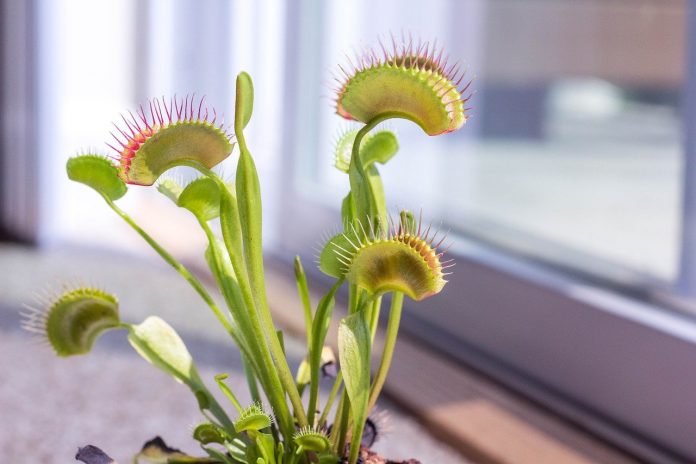My daughter got a Venus flytrap for Christmas. It came in a small self-sustaining terrarium that consists of a glass bottle, blue nutrient gel and a cork. Until it gets larger, it will be fine on her desk in its terrarium. But eventually, we’ll need to replant it.
If I manage to get it out of the bottle intact, I want to make sure I give it a good shot at survival. I want to make sure I provide the right soil and meet all its needs.
About the Venus flytrap
I never would have guessed the Venus flytrap is native to the bogs of the Carolinas. I would have guessed somewhere more exotic. However, knowing it grows well in the wet, sandy soil of the Carolinas somehow makes the prospect of growing one a little less daunting.
The Venus flytrap is a herbaceous plant with a perennial life cycle. When it’s mature it will be 6-12 inches tall by 6-9 inches wide. It prefers full sun to partial shade and it likes nutrient-poor, acidic, sandy soil that’s kept constantly wet. It blooms from May to June and has white flowers. It can be grown outdoors in hardiness zones 5-8.
Growing a Venus flytrap indoors
Venus flytrap is frequently grown as a houseplant so its carnivorous habits can be observed up close.
Incidentally, the Venus flytrap is not more difficult to take care of than other houseplants if its specific needs are met.
Soil. As with any plant, the first step to ensuring successful growth is choosing the right soil. Wild Venus flytraps grow in bogs that are constantly wet with acidic, nutrient-poor soil. Choose a soil mix that is more acidic than most houseplant mixes. Soil mixes of equal parts peat moss and perlite or horticultural sand work well to ensure soil is acidic and drains well.
Water. Keep soil moist by watering frequently. Remember the Venus flytrap likes bog-like conditions. If these plants dry out, they will die. Use distilled water or rainwater to avoid introducing unwanted minerals.
Air. Small Venus flytraps, especially those with recently disturbed roots, like humidity. Even mature plants like humidity above 50%. However, they can’t be kept in a humidity dome full-time because they require air circulation to prevent the growth of mold or fungus.
Sunlight. Venus flytraps prefer full sun to partial shade and should receive 12 hours of sunlight daily. Just be careful not to dry them out in direct sunlight.
Do not fertilize. Venus flytraps typically grow in nutrient-poor soil and feed on bugs. Using fertilizer will be a waste, but you’ll have to feed it the occasional bug to keep it happy if it’s being grown completely indoors.
Feeding your Venus flytrap. If there’s no natural source of insects for your venus flytrap to eat, you’ll need to feed it about once every two weeks. You can feed it by using tweezers to grasp live insects and make contact with the hairs inside the trap that trigger it or by adding water to soften dried Soldier larvae, mealworms or other bugs and gently massaging the outside of the trap to close.
Dormant period. Venus flytraps go dormant from October to February when sunlight levels decrease. During this time, most of their leaves will turn black or fall off while the plant rests. Although the plant may appear dead, it’s actually living underground. Don’t try to make up for the lost daylight hours by using artificial light and cut back on watering during this time.
Bloom. Venus flytraps will bloom from May to June. However, it’s a good idea to pick the flowers off to conserve energy and prevent seed production.
Propagation. Harvesting offshoots in the spring is the best way to propagate the Venus flytrap. Mature plants will send up offshoots in early spring that can be carefully removed with the roots intact and replanted as new plants. Offshoots that are replanted without the roots will not grow. Venus flytraps can also be grown from seed or leaf cuttings, but harvesting the offshoots is the easiest propagation method.











it is good and also the venus flytrap had to eat insects and it is all true